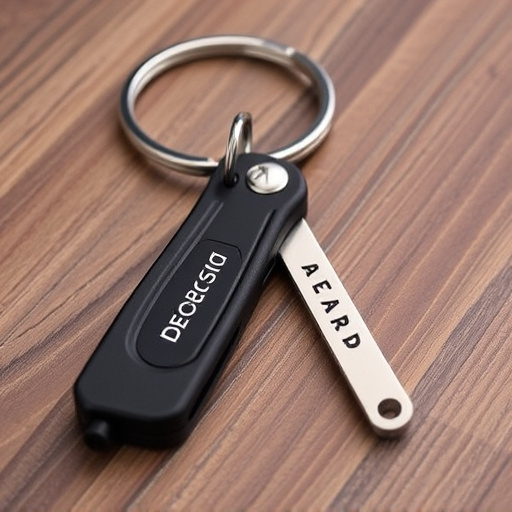In a world prioritizing personal safety, discreet personal protection keychains are gaining popularity as subtle yet powerful tools. Designed with the Proper Keychain Striking Form Technique, these keychains offer quiet and effective self-defense without drawing attention. Crafted from durable materials like stainless steel or brass, they feature strategic designs with hard edges, sharp points, and ergonomic grips for discreet deterrence or escape aid. This blend of subtlety and functionality makes them a practical game-changer for personal security, combining style and protection seamlessly.
Discreet personal protection keychains offer a subtle yet powerful tool for self-defense. In today’s world, where awareness and safety are paramount, these compact devices cater to individuals seeking peace of mind. This article explores the critical need for discreet personal protection, delving into key design considerations that ensure effectiveness without drawing unnecessary attention. We uncover how striking form techniques can enhance craftsmanship, ultimately assessing the profound impact on user safety.
- Understanding the Need for Discreet Personal Protection Keychains
- Key Design Considerations for Effective Discretion
- Incorporating Striking Form Techniques in Keychain Creation
- Assessing the Impact of Proper Keychain Craftsmanship on User Safety
Understanding the Need for Discreet Personal Protection Keychains
In today’s world, personal safety is a top priority for many individuals, especially when facing potential threats in public spaces. This has led to an increasing demand for discreet yet effective personal protection tools that can be easily carried and accessed. Discreet personal protection keychains fill this gap by offering a subtle yet powerful defense mechanism. Unlike traditional self-defense devices, these keychains are designed with the proper keychain striking form technique, ensuring they can be deployed quickly and quietly without drawing unnecessary attention.
The need for such innovative solutions is evident in various scenarios where individuals may feel vulnerable, such as walking alone at night or traveling to unfamiliar places. A discreet keychain allows users to carry a sense of security while maintaining their freedom of movement. By employing the striking form technique, these keychains provide a surprise element that can deter potential assailants, giving users time to escape or seek help. This blend of subtlety and power makes them an ideal choice for those seeking both discretion and personal protection.
Key Design Considerations for Effective Discretion
When designing a discreet personal protection keychain, the focus should be on creating a compact yet effective tool that seamlessly blends into everyday carry items. The keychain should adopt a striking form that subtly hints at its purpose while remaining largely unnoticeable. This balance between discretion and functionality is key to ensuring users can rely on it in unexpected situations without drawing unwanted attention.
The striking form technique involves clever design elements like curved edges, streamlined profiles, and the strategic use of materials. Opting for a lightweight yet durable material blend allows for ease of carrying and a subtle presence. Additionally, incorporating discreet features such as a hidden blade or non-lethal self-defense tools, concealed within the keychain’s structure, enhances its effectiveness without sacrificing discretion. The proper keychain design aims to merge form with function, turning an everyday accessory into a reliable personal safety device.
Incorporating Striking Form Techniques in Keychain Creation
Incorporating striking form techniques in keychain creation can elevate a simple accessory into a statement piece that serves both aesthetic and practical purposes. The choice of material plays a significant role; high-quality metals like stainless steel or brass, when crafted with precision, can create intricate patterns and textures that catch the eye. These materials’ natural luster and resilience ensure durability, making them ideal for personal protection keychains intended for frequent use.
Designers can employ various proper keychain striking form techniques to achieve unique outcomes. Engraving, for instance, allows for delicate detailing, while casting enables complex shapes and structures. Combining these methods can result in a captivating keychain with hidden depths, serving as both a stylish accessory and a reliable tool for self-defense or emergency situations.
Assessing the Impact of Proper Keychain Craftsmanship on User Safety
The craftsmanship of a keychain goes beyond its aesthetic appeal; it directly impacts user safety, especially in emergency situations. When designed with a proper striking form technique, a keychain becomes more than just an accessory—it’s a potent tool for self-defense. This subtle yet powerful feature ensures users can defend themselves discreetly if needed.
The impact lies in the balance between functionality and subtlety. A well-crafted keychain should seamlessly blend into daily life while housing components that can serve as a deterrent or means of escape during risky encounters. The proper striking form technique involves incorporating hard edges, sharp points, or other ergonomic designs that can be effectively used to ward off attackers without drawing excessive attention. This thoughtful design choice enhances personal security without compromising the keychain’s portability and convenience.
The discreet personal protection keychain is more than just a stylish accessory; it’s an innovative solution for enhancing individual safety. By combining subtle design with robust functionality, these keychains offer peace of mind in various settings. Incorporating striking form techniques and prioritizing proper craftsmanship ensures that users can protect themselves effectively without drawing unnecessary attention. When designed thoughtfully, these keychains become powerful tools, empowering individuals to stay safe discreetly.
